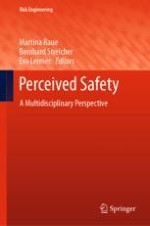2019 | OriginalPaper | Buchkapitel
5. Psychological Perspectives on Perceived Safety: Zero-Risk Bias, Feelings and Learned Carelessness
verfasst von : Martina Raue, Elisabeth Schneider
Erschienen in: Perceived Safety
Aktivieren Sie unsere intelligente Suche, um passende Fachinhalte oder Patente zu finden.
Wählen Sie Textabschnitte aus um mit Künstlicher Intelligenz passenden Patente zu finden. powered by
Markieren Sie Textabschnitte, um KI-gestützt weitere passende Inhalte zu finden. powered by
